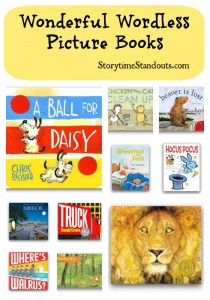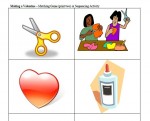Reading and Interpreting Pictures Supports Reading Comprehension

What could your child tell you about this picture? Would she say that it is Fall? Would she predict that the family is choosing a pumpkin for Halloween?
Reading and interpreting pictures includes noticing what is in the picture, what the characters are doing, the weather or time of day and other details (i.e. the color of a character’s clothing). A child could be asked to interpret the scene and confirm comprehension by telling or retelling the narrative.
For the first picture, we could ask questions such as what do you think these people are doing? or why do you think the man is pushing the wheelbarrow? or Why do you think these people are visiting a pumpkin patch?
Why does one man have gold coins in his hand? or Do you see anything that looks usual in this picture?
Wordless Picture Books Encourage Children to Interpret and Comprehend
 Wordless picture books are great tools for helping children to develop good comprehension and interpretation skills. We invite you to visit our Wordless Picture Books page to discover why great wordless picture books make narratives easily understood. Once a child has ‘read’ a wordless picture book with an adult, he should be encouraged to share the book with someone else. Making an opportunity to reconstruct and retell a story is valuable for a young child because reconstructing and retelling a story is a way to confirm comprehension.
Wordless picture books are great tools for helping children to develop good comprehension and interpretation skills. We invite you to visit our Wordless Picture Books page to discover why great wordless picture books make narratives easily understood. Once a child has ‘read’ a wordless picture book with an adult, he should be encouraged to share the book with someone else. Making an opportunity to reconstruct and retell a story is valuable for a young child because reconstructing and retelling a story is a way to confirm comprehension.
Sequencing Activities = Reading and Interpreting Pictures
Children who have learned to ‘read’ and ‘interpret’ pictures will benefit from sequencing activities. These provide children with the opportunity to ‘read’ pictures and determine the correct order of events.
 Here are links to three printable sequencing activities from my website and three from elsewhere on the internet.
Here are links to three printable sequencing activities from my website and three from elsewhere on the internet.
 Building a Snowman Sequencing Activity
Building a Snowman Sequencing Activity

 Planting a Flower Garden Sequencing Activity
Planting a Flower Garden Sequencing Activity

 Valentine's Day Sequencing Activity
Valentine's Day Sequencing Activity
Cut this Valentine's Day Sequencing Activity apart and have children put it together in the correct order or print two and use as a matching game.
British Council Goldilocks and the Three Bears Sequencing Printable
DLTK’s Story Sequencing Activities
For additional information about comprehension and reading readiness, follow this link to our page about reading comprehension.










































